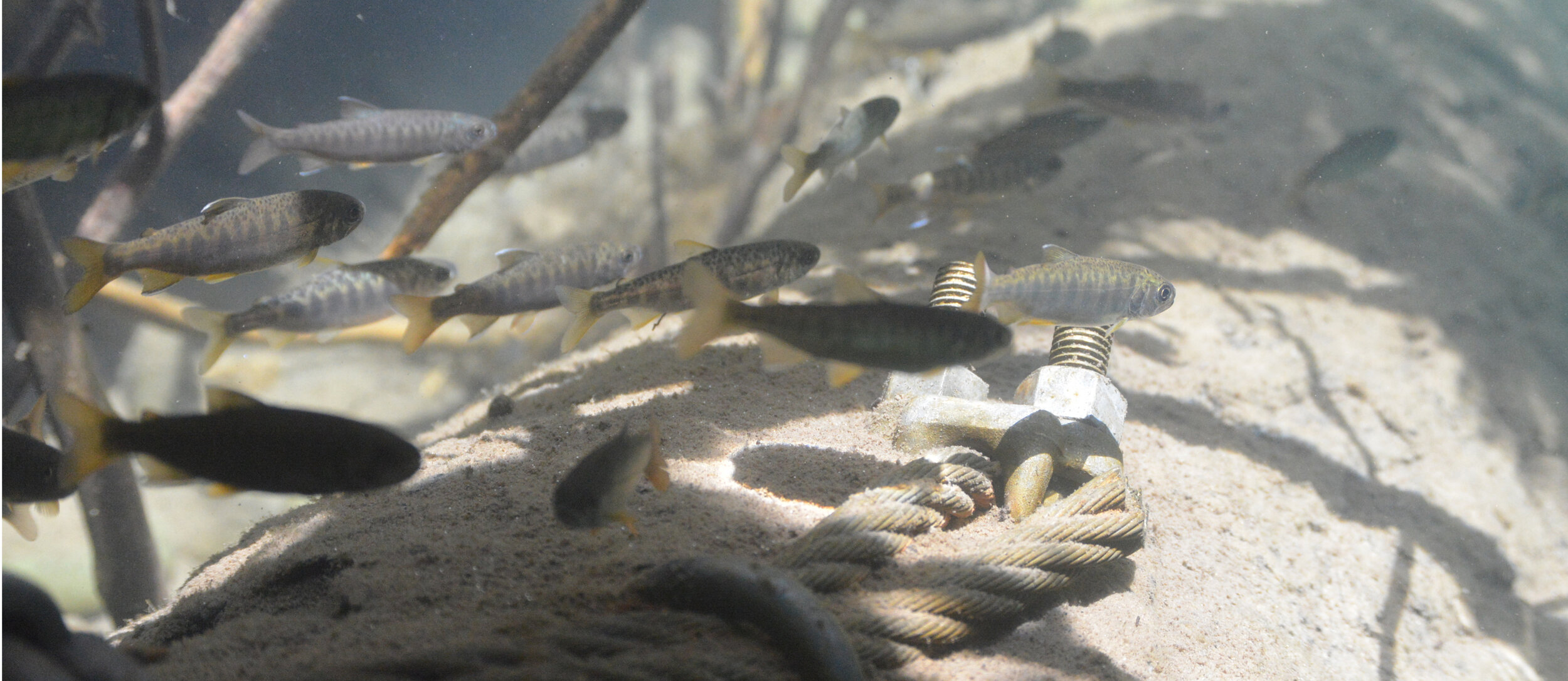Research & Monitoring
Project Effectiveness Monitoring
To increase the success of future projects, we monitor our past efforts to better evaluate how fish respond to instream restoration projects to find out if these projects are successfully providing habitat for Spring Chinook salmon, steelhead, bull trout, Pacific lamprey, and other native fish. Results of this monitoring have revealed increased use by these species at many of Methow Salmon’s restoration sites, helping confirm that specific instream restoration activities correlate to enhanced fish use. Watch a short video describing post project monitoring at the MacPherson Side Channel and Riparian Restoration Project and Plummer Spring Channel Connection Project.
Snorkel surveys show the high densities of salmonids in both natural log jams and engineered wood structures.
Water Quality Monitoring
Methow Salmon has monitored water quality throughout the Methow since 2010. The primary focus of this effort has been to develop a baseline of stream water temperature in order to document the status and trends in temperature profiles of various streams throughout the watershed. The data derived from this monitoring is being used in many ways, including assessment of restoration project effectiveness, supporting aquatic productivity models, fish habitat suitability analyses, and determining how restoration actions improve stream temperatures and sediment load. .
Other water quality monitoring efforts being completed by MSRF and other groups include spawning surveys, temperature and general water quality monitoring (pH, dissolved oxygen, conductivity, chlorophyll, and turbidity) to track baseline conditions in various locations in the Methow, Twisp, and Chewuch Rivers.
Methow Salmon’s water quality monitoring program has been funded by several grants through the Washington Department of Ecology.
Bull Trout Population Monitoring
Bull trout are extremely sensitive to water quality degradation, and they only spawn in cold, clear streams. Population monitoring consists of documenting spawning locations in more than a dozen streams. Where streams can be sampled, spawning sites (redds) are mapped and documented. In addition to the location of redds, other information, such as spawning habitat characterization, fish observations, and water temperatures is collected to further our understanding of this species.
Many bull trout spawning areas are located in high elevation streams within the Pasayten and Chelan-Sawtooth Wilderness Areas. Since it is not feasible to survey every small stream in the watershed, environmental DNA sampling is used to help define the distribution of bull trout in unsurveyed streams. This sampling involves filtering stream water onto a piece of paper, which can then be analyzed for bull trout DNA in the laboratory. Initial results of this sampling have revealed several new areas of bull trout presence. These data provide information critical to the long-term conservation of this imperiled species.
Bull trout population monitoring in the Methow is being completed as a partnership between the Methow Salmon, U.S. Fish and Wildlife Service, U.S. Forest Service, and Washington Department of Fish and Wildlife. Our efforts are supported by the Washington Salmon Recovery Funding Board, Bonneville Environmental Foundation, and several dedicated volunteers
Riparian Vegetation Monitoring
Vegetation along the streambank stabilizes soils, provides nutrients, reduces water temperature, offers valuable habitat to species in and out of the water. Riparian vegetation in the Methow watershed has been significantly impacted wildfire, agricultural practices, development, and other human activities. To address the loss of riparian vegetation, locally-propagated, native riparian plantings are a major component of Methow Salmon’s restoration projects.
We monitor plant survival, growth, and shade at several restoration sites. Methow Salmon uses the monitoring data to inform and refine planting techniques, watering schedules, and deer and rodent browse protection methods to increase the overall effectiveness of the plantings. This program has led to a more intensive and sustained maintenance effort for the first full 5 years following planting. After this period, we have found that the established planting areas become self-sustaining.
New plantings are protected by cages to reduce the effect of deer browse. These cages are removed as the plants mature.
Lamprey Monitoring
Methow Salmon has been active in monitoring larval Pacific lamprey in the Methow and Chewuch Rivers since 2008. The lamprey population in the Methow reached extremely low levels by 2014 and concern was growing over the long-term viability of this species. Adult translocation efforts were initiated by the Yakama Nation in 2015, and Methow Salmon’s on-going monitoring will help track how this effort, as well as on-going habitat restoration, are assisting in the recovery of this ancient species.
Western brook lamprey have recently been documented as present in the Methow watershed – the result of monitoring conducted by Methow Salmon and the Yakama Nation. To date, all observations have been of ammocoetes and no adult observations have been made. Unlike anadromous Pacific lamprey, Western brook lamprey are stream resident fish.






